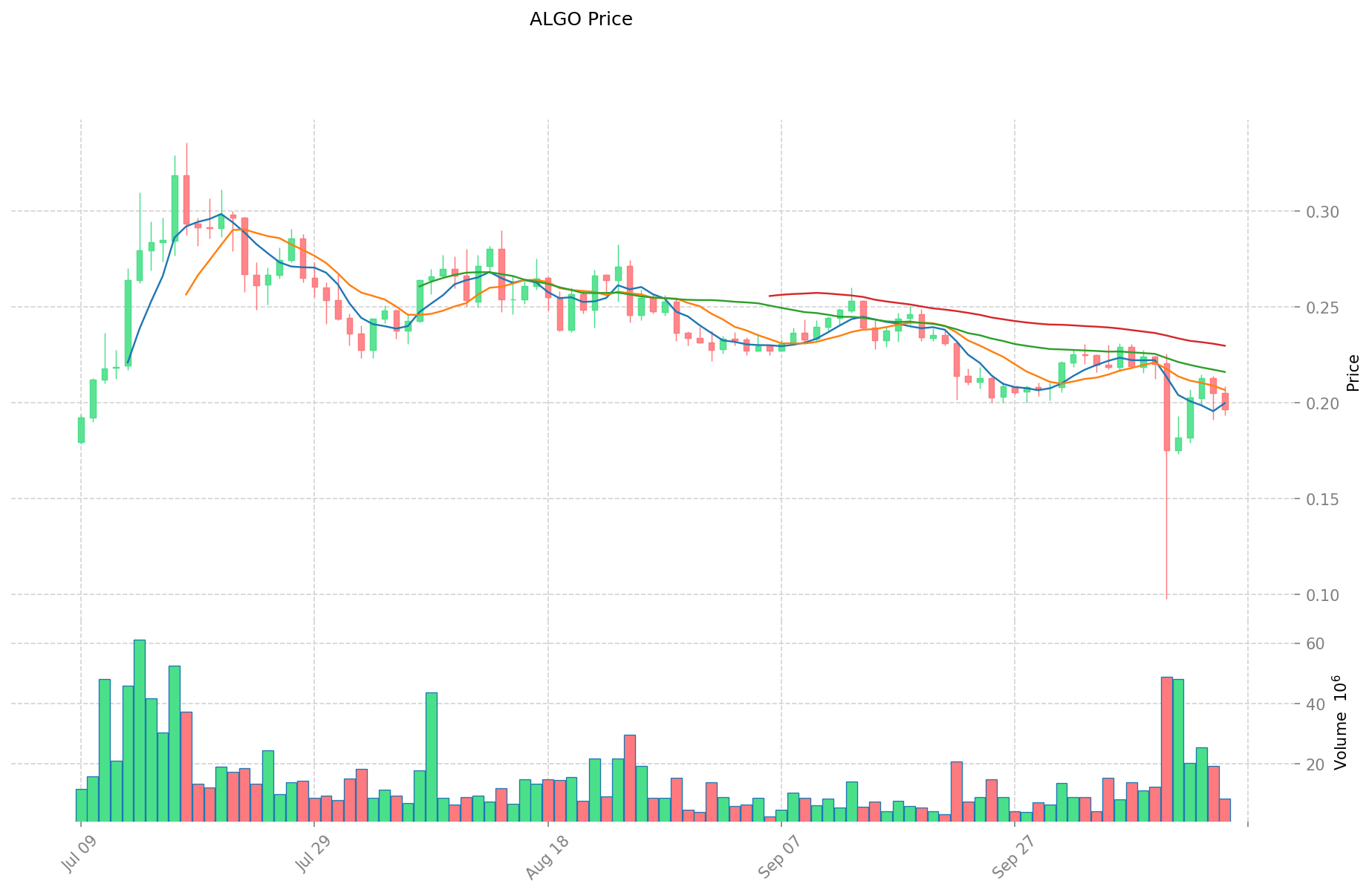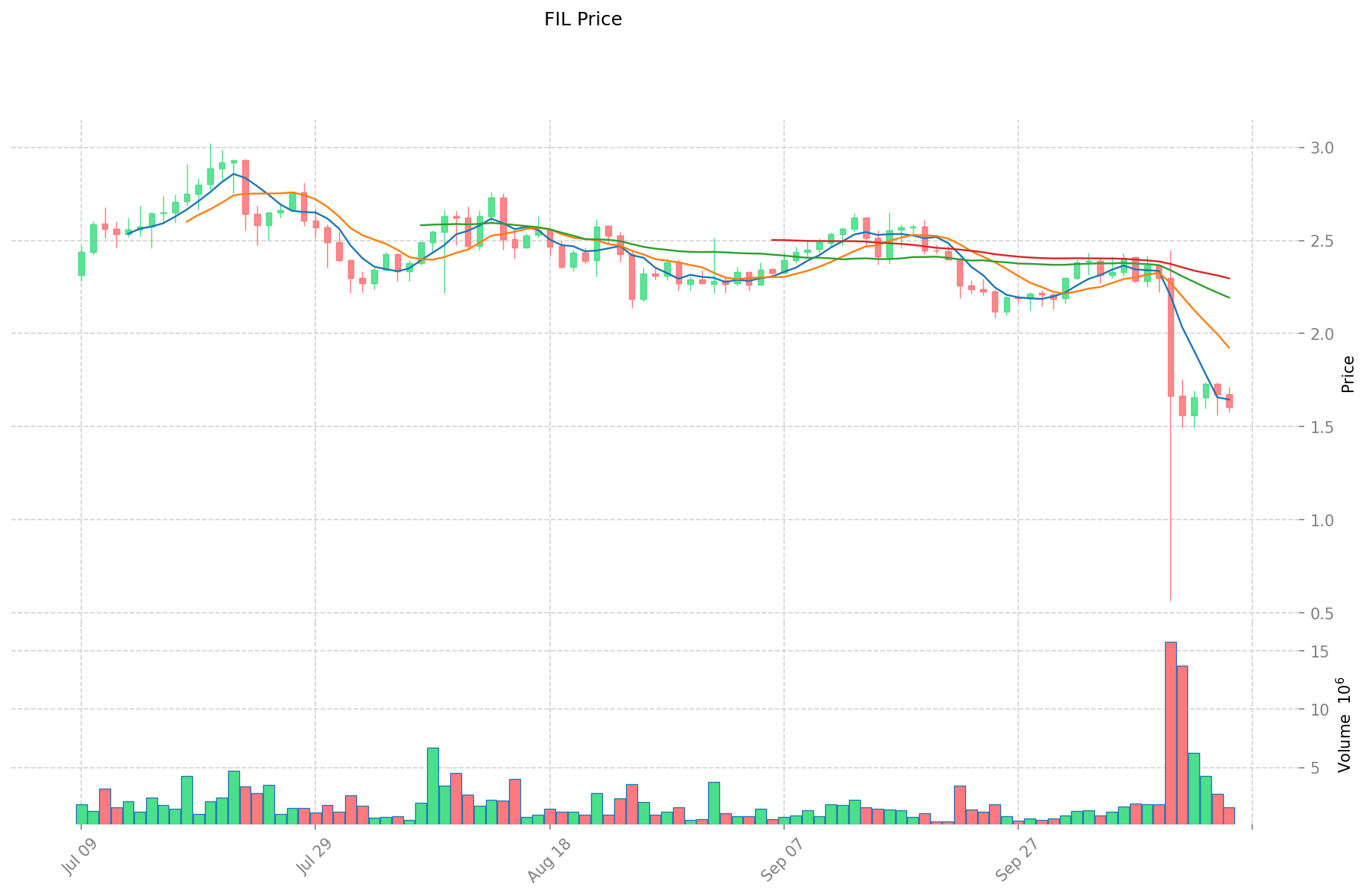ALGO vs FIL: Comparing Two Leading Blockchain Storage Solutions
Introduction: Investment Comparison of ALGO vs FIL
In the cryptocurrency market, the comparison between Algorand (ALGO) and Filecoin (FIL) has been an unavoidable topic for investors. The two not only show significant differences in market cap ranking, application scenarios, and price performance but also represent different positioning in the crypto asset space.
Algorand (ALGO): Since its launch in 2019, it has gained market recognition for its innovative approach to blockchain efficiency and scalability.
Filecoin (FIL): Introduced in 2020, it has been hailed as a decentralized storage solution, becoming one of the most notable projects in the blockchain infrastructure space.
This article will provide a comprehensive analysis of the investment value comparison between ALGO and FIL, focusing on historical price trends, supply mechanisms, institutional adoption, technological ecosystems, and future predictions, aiming to answer the question most crucial to investors:
"Which is the better buy right now?"
I. Price History Comparison and Current Market Status
ALGO (Algorand) and FIL (Filecoin) Historical Price Trends
- 2021: ALGO price surged to its all-time high of $3.56 due to increased adoption and ecosystem growth.
- 2021: FIL reached its peak price of $236.84 in April, driven by the growing demand for decentralized storage solutions.
- Comparative analysis: During the 2022 bear market, ALGO dropped from its high of $3.56 to a low of $0.087513, while FIL declined from $236.84 to $0.848008.
Current Market Situation (2025-10-16)
- ALGO current price: $0.19627
- FIL current price: $1.603
- 24-hour trading volume: ALGO $1,685,324.77 vs FIL $2,599,525.74
- Market Sentiment Index (Fear & Greed Index): 34 (Fear)
Click to view real-time prices:
- Check ALGO current price Market Price
- Check FIL current price Market Price


II. Core Factors Affecting the Investment Value of ALGO vs FIL
Supply Mechanism Comparison (Tokenomics)
- ALGO: Pure proof-of-stake consensus mechanism with focus on efficiency and security
- FIL: Decentralized storage network with tokenomics tied to storage capacity and utilization
- 📌 Historical Pattern: Supply mechanisms drive price cycles based on blockchain adoption trends and network utility.
Institutional Adoption and Market Applications
- Institutional Holdings: Limited information on institutional preference between the two
- Enterprise Adoption: ALGO's blockchain efficiency compared to FIL's decentralized storage solutions
- Regulatory Attitudes: Varying regulatory approaches to blockchain technologies across jurisdictions
Technological Development and Ecosystem Building
- ALGO Technical Upgrades: Algorand blockchain emphasizes high efficiency and security features
- FIL Technical Development: Filecoin network focuses on decentralized storage infrastructure
- Ecosystem Comparison: Both platforms developing distinct ecosystems with different use cases and applications
Macroeconomic Factors and Market Cycles
- Inflation Performance: Both assets affected by broader cryptocurrency market trends
- Monetary Policy Impact: Interest rates and USD strength influence overall crypto market sentiment
- Geopolitical Factors: Cross-border transaction demands may affect utility and adoption rates
III. Price Prediction 2025-2030: ALGO vs FIL
Short-term Prediction (2025)
- ALGO: Conservative $0.108 - $0.196 | Optimistic $0.196 - $0.206
- FIL: Conservative $1.36 - $1.60 | Optimistic $1.60 - $2.19
Mid-term Prediction (2027)
- ALGO may enter a growth phase, with estimated prices $0.24 - $0.36
- FIL may enter a bullish market, with estimated prices $1.12 - $3.17
- Key drivers: Institutional inflows, ETF developments, ecosystem growth
Long-term Prediction (2030)
- ALGO: Base scenario $0.39 - $0.55 | Optimistic scenario $0.55+
- FIL: Base scenario $3.86 - $4.44 | Optimistic scenario $4.44+
Disclaimer: This analysis is for informational purposes only and should not be considered as financial advice. Cryptocurrency markets are highly volatile and unpredictable. Always conduct your own research before making investment decisions.
ALGO:
| 年份 | 预测最高价 | 预测平均价格 | 预测最低价 | 涨跌幅 |
|---|---|---|---|---|
| 2025 | 0.206241 | 0.19642 | 0.108031 | 0 |
| 2026 | 0.28991592 | 0.2013305 | 0.155024485 | 2 |
| 2027 | 0.3635223508 | 0.24562321 | 0.2382545137 | 25 |
| 2028 | 0.423356164756 | 0.3045727804 | 0.173606484828 | 55 |
| 2029 | 0.4185591434647 | 0.363964472578 | 0.34212660422332 | 85 |
| 2030 | 0.54776653122989 | 0.39126180802135 | 0.367786099540069 | 99 |
FIL:
| 年份 | 预测最高价 | 预测平均价格 | 预测最低价 | 涨跌幅 |
|---|---|---|---|---|
| 2025 | 2.19474 | 1.602 | 1.3617 | 0 |
| 2026 | 2.4109299 | 1.89837 | 1.3478427 | 18 |
| 2027 | 3.1673354265 | 2.15464995 | 1.120417974 | 34 |
| 2028 | 3.61895005602 | 2.66099268825 | 1.3571062710075 | 65 |
| 2029 | 4.5843582033171 | 3.139971372135 | 2.3235788153799 | 95 |
| 2030 | 4.441489505884957 | 3.86216478772605 | 3.591813252585226 | 140 |
IV. Investment Strategy Comparison: ALGO vs FIL
Long-term vs Short-term Investment Strategies
- ALGO: Suitable for investors focused on blockchain efficiency and scalability
- FIL: Suitable for investors interested in decentralized storage solutions
Risk Management and Asset Allocation
- Conservative investors: ALGO: 40% vs FIL: 60%
- Aggressive investors: ALGO: 60% vs FIL: 40%
- Hedging tools: Stablecoin allocation, options, cross-currency portfolios
V. Potential Risk Comparison
Market Risk
- ALGO: Volatility due to market sentiment and adoption rates
- FIL: Fluctuations based on demand for decentralized storage
Technical Risk
- ALGO: Scalability, network stability
- FIL: Storage provider concentration, security vulnerabilities
Regulatory Risk
- Global regulatory policies may have differing impacts on both assets
VI. Conclusion: Which Is the Better Buy?
📌 Investment Value Summary:
- ALGO advantages: Innovative blockchain efficiency, scalability potential
- FIL advantages: Growing demand for decentralized storage, unique use case
✅ Investment Advice:
- New investors: Consider a balanced approach, leaning towards ALGO for its potential growth
- Experienced investors: Evaluate both assets based on your risk tolerance and portfolio diversification needs
- Institutional investors: Assess both assets for their specific use cases and potential integration with existing systems
⚠️ Risk Warning: Cryptocurrency markets are highly volatile. This article does not constitute investment advice. None
VII. FAQ
Q1: What are the main differences between ALGO and FIL? A: ALGO focuses on blockchain efficiency and scalability, while FIL specializes in decentralized storage solutions. ALGO uses a pure proof-of-stake consensus mechanism, whereas FIL's tokenomics are tied to storage capacity and utilization.
Q2: Which cryptocurrency has performed better historically? A: Both ALGO and FIL reached their all-time highs in 2021, with ALGO peaking at $3.56 and FIL at $236.84. However, both experienced significant declines during the 2022 bear market, with ALGO dropping to $0.087513 and FIL to $0.848008.
Q3: What are the current prices and market sentiments for ALGO and FIL? A: As of 2025-10-16, ALGO's price is $0.19627, while FIL's price is $1.603. The market sentiment, as indicated by the Fear & Greed Index, is at 34, suggesting a state of fear in the overall crypto market.
Q4: How do the supply mechanisms of ALGO and FIL differ? A: ALGO employs a pure proof-of-stake consensus mechanism focused on efficiency and security. FIL, on the other hand, has a tokenomics model tied to storage capacity and utilization within its decentralized storage network.
Q5: What are the long-term price predictions for ALGO and FIL? A: By 2030, ALGO's base scenario price range is predicted to be $0.39 - $0.55, with an optimistic scenario of $0.55+. For FIL, the base scenario price range is $3.86 - $4.44, with an optimistic scenario of $4.44+.
Q6: How should investors allocate their assets between ALGO and FIL? A: For conservative investors, a suggested allocation is 40% ALGO and 60% FIL. For aggressive investors, the recommendation is 60% ALGO and 40% FIL. However, these allocations should be adjusted based on individual risk tolerance and investment goals.
Q7: What are the main risks associated with investing in ALGO and FIL? A: Both cryptocurrencies face market risks due to volatility. ALGO's technical risks include scalability and network stability issues, while FIL faces risks related to storage provider concentration and potential security vulnerabilities. Both are also subject to regulatory risks that may vary by jurisdiction.
Share
Content